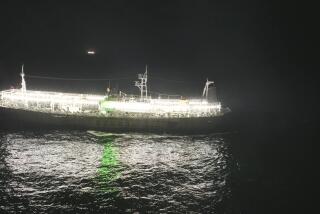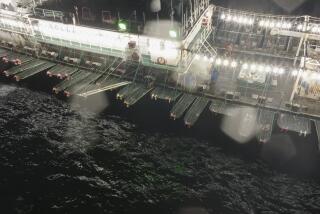Brazilâs Fishermen--Jangadeiros--Cling to Tradition as They Reap Seaâs Bounty
FORTALEZA, Brazil â Just before sunset, the fishermen sail into Fortaleza Harbor on their rafts and dump the dayâs catch of mackerel, moray eels and red snappers on the sand. People gather around shouting their bids.
Fisherman Raminundo Nonato Tavares comes away with 13,000 cruzados (about $13)--not bad for a dayâs work, but nothing like the old times.
âWhen I was a boy, weâd fish for half the time we do now and catch twice as much,â said Tavares, who is 40 but whose weather-beaten face looks years older.
âWe used to come to port with the boat weighing low in the water from all the fish,â Tavares said during a recent visit.
Tavares is one of thousands of men on Brazilâs northeast coast who for years have been fishing on jangadas , or small wooden rafts, but who now see their livelihood disappearing.
Overfishing by big commercial trawlers and a boom in the shrimp trade, which kills tons of fish, have been cutting into their catch and forcing many to seek steadier work on trawlers.
About 200 jangadas now sail out of Fortaleza Harbor, where 20 years ago there were about double that number, said Wilson Goncalves, president of the local fishermenâs union in this city of 1.3 million people.
Work is risky on a jangada , not much bigger than a double bed and powered only by the wind, and the fishing season lasts only six months a year, as the sea is too stormy in winter.
But jangadeiros , as the fishermen are known, cling to tradition.
They refuse the usual equipment for commercial fishing like motors, nets and compasses, relying entirely on hook and line and a knowledge passed down from generations of how to find the fish.
Most are illiterate and, since their early teens, have never changed their routine of sailing out to sea before dawn and returning before sunset.
They bring most of their catch home to their families and sell the rest to tide them over during the winter months.
âThe jangadeiro does not understand or want technology. Heâs a subsistence fishermen who will rely on custom until the day he dies,â said Goncalves.
Custom has well-served Tavares and other jangadeiros for generations.
He can tell by the color of the water which fish will be most plentiful in a certain area. Darker, deeper water suggests the presence of mackerel, grouper and--if itâs a lucky day--shark.
A green hue often means a coral reef lies below, and that means the moray eel, which will bring Tavares a high price because of its tasty meat and because trawlers using nets rarely snare them.
Using the weather, ocean currents and even the phases of the moon as his guides, he says, he can almost always find the kind of fish he is seeking.
âMy father taught me most of it, but some of it I had to learn myself. The sea is always changing,â he said as he cast his line in a place that he thought would yield red snapper, a small, ruddy fish. Within half an hour, he had caught five.
But the 20th Century is closing in on the jangadeiros , who bitterly resent the commercial trawlers they say are emptying their waters of fish.
âSo many fish in the ocean, and our share is so small after the fishing boats come through,â said Francisco dos Reis, who often joins Tavares on his craft.
âWe used to be able to fill that basket with fish. Now weâre lucky if we can fill it halfway after a whole day at sea,â Dos Reis said.
One reason for the drop in their catch is the boom in Fortalezaâs shrimp industry, which exports heavily to the United States.
When shrimp fishermen haul in their nets, they also bring in thousands of fish that have gotten entangled and died. The fishermen throw them overboard because, unlike the shrimp, fish wonât bring in coveted export dollars.
More to Read
Sign up for Essential California
The most important California stories and recommendations in your inbox every morning.
You may occasionally receive promotional content from the Los Angeles Times.










